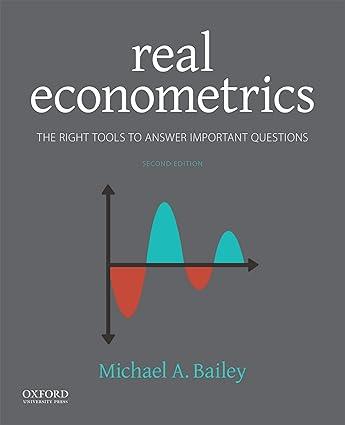The data set MLBattend.dta contains Major League Baseball attendance records for 32 teams from the 1970s through
Question:
The data set MLBattend.dta contains Major League Baseball attendance records for 32 teams from the 1970s through 2000.
(a) Estimate a regression in which home attendance rate is the dependent variable and runs scored is the independent variable. Report your results, and interpret all coefficients.
(b) Use the standard error from your results to calculate the statistical power of a test of \(\mathrm{H}_{0}: \beta_{\text {runs_scored }}=0\) versus \(\mathrm{H}_{\mathrm{A}}\) : \(\beta_{\text {runs_scored }}>0\) with \(\alpha=0.05\) (assuming a large sample for simplicity) for three cases:
(i) \(\beta\) runs_scored \(=100\)
(ii) \(\beta\) runs_scored \(=400\)
(iii) \(\beta_{\text {runs_scored }}=1,000\)
(c) Suppose we had much less data than we actually do, such that the standard error on the coefficient on \(\beta_{\text {runs _ scored were }} 900\) (which is much larger than what we estimated). Use the standard error of \(\beta_{\text {runs_scored }}=900\) to calculate the statistical power of a test of \(\mathrm{H}_{0}\) : \(\beta_{\text {runs_scored }}=0\) versus \(\mathrm{H}_{\mathrm{A}}: \beta_{\text {runs_scored }}<0\) with \(\alpha=0.05\) (assuming a large sample for simplicity) for the three cases described in part (b).
(d) Suppose we had much more data than we actually do, such that the standard error on the coefficient on \(\beta_{\text {runs_scored }}\) were 200 (which is much smaller than what we estimated). Use the standard error of \(\beta_{\text {runs_scored }}=100\) to calculate the statistical power of a test of \(\mathrm{H}_{0}\) : \(\beta_{\text {runs_scored }}=0\) versus. \(\mathrm{H}_{\mathrm{A}}\) : \(\beta\) runs _scored \(>0\) with \(\alpha=0.05\) (assuming a large sample for simplicity) for the three cases described in part (b).
(e) Discuss the differences across the power calculations for the different standard errors.
Step by Step Answer:

Real Econometrics The Right Tools To Answer Important Questions
ISBN: 9780190857462
2nd Edition
Authors: Michael Bailey





